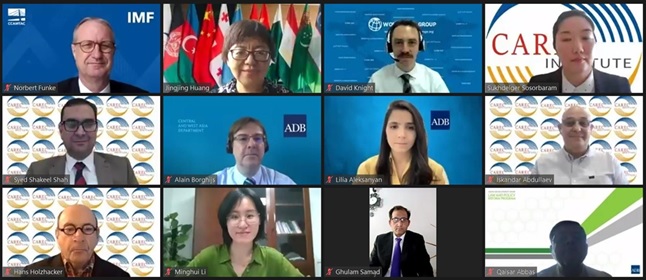Workshop on “Debt and Financial Sustainability in the CAREC Region”

On August 24, the CAREC Institute hosted a webinar on “Debt and Financial Sustainability in the CAREC Region” that discussed the comprehensive overview of the debt situation and fresh evidence on broad-based debt accumulation in the CAREC region by considering the individual country growth dynamics.
Mr. Syed Shakeel Shah, Director of the CAREC Institute, in his welcoming speech, emphasized the importance of public and external borrowing as an important economic tool to finance critical investments – crucial for accelerating economic development and growth, more importantly, coping with the effects of crisis caused by the COVID-19 pandemic. The COVID-19 pandemic and the ongoing geopolitical conflict in Ukraine have presented developing countries with difficult challenges in maintaining their financial health. To maintain existing long-term policies, governments are often forced into costly fiscal support packages to counter economic shock and manage inflation. This increases borrowing. As a result, the debt situation in developing countries is deteriorating, which puts pressure on the balance of payment deficit and foreign exchange reserves. To overcome the fiscal crisis, the CAREC countries must have effective debt management and debt transparency mechanisms in place. Furthermore, constant economic restructuring reform needs to be held to strengthen the competitiveness of domestic economies to increase export revenue and improve resource mobilization. Strengthening the combination of macroeconomic policy with fiscal policy framework together with debt management strategy is crucial to ensure the debt sustainability of the CAREC countries.
Dr. Ghulam Samad, the Senior Research Specialist of the CAREC Institute, discussed the findings of Chapter 4 of the CAREC Institute’s Annual book “Debt and Debt Sustainability in the CAREC Region.” He stressed that debt sustainability is not a technical assessment though a lot of technical issues feed into the debt sustainability assessments but eventually, debt sustainability is judgmental as it considers lots of different economic things. Debt sustainability should not be linked to a threshold; if a country is above or below that threshold will be regarded as debt unsustainable or sustainable. The level of debt is not important for a country’s assessment, but three important factors like structure of the debt, the nature of economic policies, and the trajectory going forward. The level of debt (debt to GDP) in the advanced economies is around 150%; in contrast, the level of debt to GDP in Sri Lanka and Pakistan was around 100% and 75%, respectively. The impact in terms of debt stress or debt default is visible in Sri Lanka and Pakistan.
Resident and non-resident debt paint a very different picture, highlighting the importance of the disaggregated debt structure dimension in debt sustainability analysis, which implies different approaches to debt management. The study also shows that sustained large budget deficits, current account deficits, currency depreciation, reduced foreign direct investment, and depletion of foreign exchange reserves are the main causes of public and external debts. Some countries in the region are facing liquidity and solvency problems caused by the historical structure of their economies, the conflict in Ukraine, inflation in the region, and debt repayments. The study suggests that the CAREC countries should continue with tax policy reforms, financial sustainability strategies, and expenditure control and optimization. More importantly, countries must increase their exports and restructure their economies for sustainable economic growth.
The invited experts from the World Bank, the ADB, the ADBI, the IMF, the CAREC Institute, and partner organizations discussed key issues related to debt management in the CAREC region, as well as ways to resolve the debt crisis and achieve debt sustainability in the current post-crisis period. The experts agreed that the pandemic has impacted debt performance in almost all CAREC countries and suggested that countries’ recovery policies should target at the green and inclusive economic growth and include measures to implement structural reforms and attract more investment from the private sector by improving the business environment, strengthening regional communication and closer coordination with international financial institutions. Furthermore, while emphasizing the significance of the capacity of the debt management intuitions and policy makers’ ability to respond to market conditions on time, the experts stressed the importance of the work of the CAREC Program and the CAREC Institute to promote macroeconomic policy dialogue, regional learning and coordination, including the development of appropriate countercyclical policy responses at the regional level.
At the end of the webinar, Dr. Iskandar Abdullaev, Deputy Director two of the CAREC Institute, concluded the discussion by underlining the role of development partners in enhancing the quality of the debt management institutions in the CAREC countries, and the importance of in-depth analysis and transparency for stronger coordination between macroeconomic policy, fiscal framework and debt management strategy in the medium term.